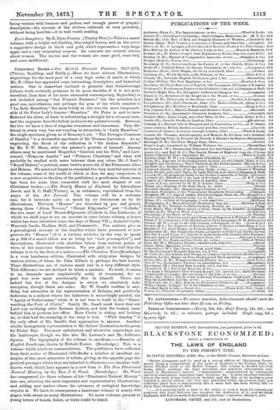CR9.167'51A8 Boors.—Our British Portrait Painters, 1617-1872. (Virtue, Spalding, and Daldy.)—Here
we have sixteen illustrations, engravings for the most part of a very high order of merit, to which Mr. E. Oilier has appended some interesting, descriptive, and historical notices. One is somewhat inclined to grumble that Gainsborongh (whose work certainly promises to be more durable, if it is not more excellent, than that of his more successful contemporary, BoyneIda) is not included among "Our Portrait Painters;' but the selection is a good one, nevertheless, and perhaps the gem of the whole number is "La Belle Hamilton," the most lovely as she was the most irreproach- able of Sir Peter Lely's famous "Beauties." Sir Peter is said to have flattered his sitter, at least in substituting a straight for a retrousse nose, and the engraver does the fullest justice to the painter's work. Between the two we have a face of singular sweetness and innocence. Very dif- ferent in every way, but not wanting in attraction, is "Lady Hamilton," the single specimen given us of Romney's art. "The Dowager Countess of Darnley " is a favourable specimen of Sir Thomas Lawrence. As an engraving, the finest of the collection is " Sir Joshua Reynolds," by Mr. T. W. Hunt, after the painter's portrait of himself. Among others may be mentioned Hogarth's "Garrick and his Wife," and Law- rence's "Princess Amelia " and " Princess Charlotte," and what will probably be studied with more interest than any other, Mr. J. Sant's "Royal Sisters," a portrait, some twelve years old, of the Princesses Alice and Helena. We must not forget to commend the very tasteful exterior of the volume, some of the credit of which is due, we may conjecture, to a new acquisition to the firm of the publishers, a gentleman whose name has been for some time connected with the most elegant of our Christmas books.—The Stately Homes of England by Llewellynn Jewitt and S. C. Hall (Virtue), is, in substance, reproduced from the pages of the Art Journal. The volume will be a welcome one, for it interests quite as much by its letterpress as by its illustrations. Thirteen "Homes " are described by pen and pencil, among them "Alton Towers," "Mount Edgcumbe," and "Cothele," the two seats of Lord Mount-Edgcumbe (Cothele is, like Littlecote, of which we shall hope to see an' account in some future volume, a house which has been inhabited since the days of Henry VII.), Arundel Castle, 'Warwick Castle, Haddon Hall, and Chatsworth. The authors give us a genealogical account of the families which have possessed or now possess the "Homes " (it is a curious mistake, by the way, to speak on p. 204 of a man's oldest son as being his "heir presumptive"), and descriptions, illustrated with sketches taken from various points of view, of the mansions themselves. We are glad to be told that the volume is to be the first of a series.—The Christian Year (Routledge) is a very handsome edition, illustrated with sixty-nine designs, by various artists, of whom Sir John Gilbert is perhaps the best known. These illustrations are of various merit and in a very different style. This difference we are inclined to think a mistake. No book, it seems to us, demands more emphatically unity of treatment, for no poet was ever more consistently like to himself. There are indeed but few of the designs to which we absolutely take exception, though there are some. Mr. W. Small's realism is any- 'thing but attractive in his representation of Balsam, and positively ludicrous in a subject where the ludicrous is exceedingly painful, the "Agony of Gethsemane," while it is not true to itself in the "Sinner washing the Feet of Christ." Surely Mr. Small must know that our Lord was reclining after Eastern fashion, and that the woman came behind him to perform her office. Here Christ is sitting and looking on, so that half the meaning of the story is lost. "Whit Sunday" is the only effort of Mr. Small's that approaches to success. Another wholly incongruous representation is Mr. Selena' illustration to the poem for Easter Day. The_most satisfactory and attractive engravings are the landscapes, though we like also Mr. Lawson's and Mr. Jellicoe's figures. The typography of the volume is excellent —Beauties of -English Landscape, drawn by Birkett Foster. (Rontledge.) This is a volume which needs no commendation. The publishers have collected from their series of Illustrated Gift-Books a number of excellent ex- amples of this most attractive of artists, giving on the opposite page the poetical passages which they are intended to illustrate.—Another well- known work which here appears in a new form is The New Illustrated _Natural History, by the Rev. J. G. Wood. (Routledge.) Mr. Wood has compressed the three volumes of his "Illustrated Natural History " into one, selecting the most important and representative illustrations, and adding new matter where the advances of zoological knowledge require its We have in consequence a handsome volume of nearly 800 pages, with about as many illustrations. No more welcome present to young lovers of beasts, fishes, or birds could be found.






































 Previous page
Previous page